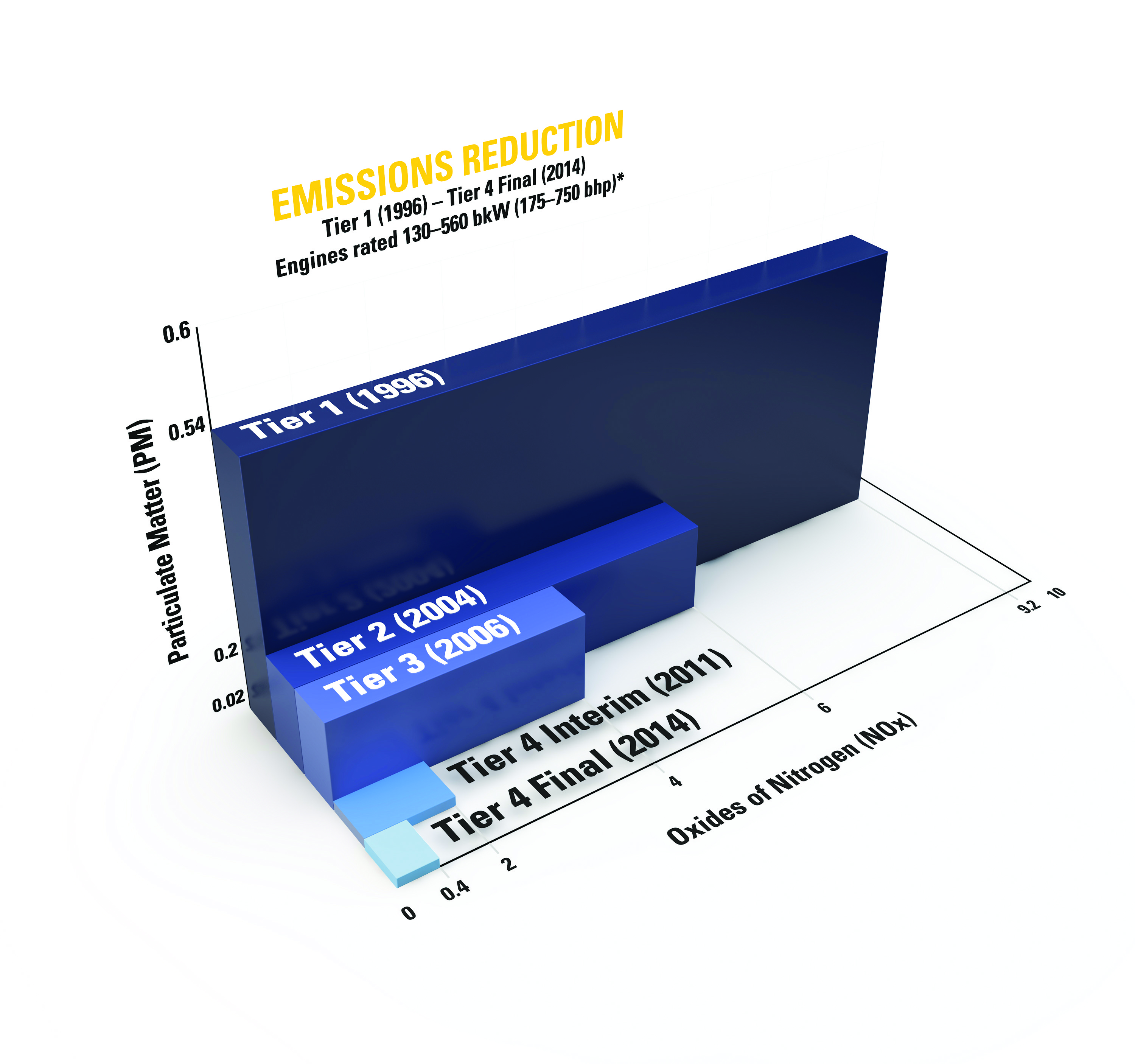Since 1996, a “tiered” series of emissions regulations has been in effect, establishing progressively stringent standards for allowable levels of oxides of nitrogen (NOx) and particulate matter (PM) released into the environment by new off-road and non-road diesel engines and equipment.

Essentially, Tier 0 engines are unregulated and most often mechanically rather than electronically controlled; Tier 1, Tier 2, and Tier 3 engines include technologies that have become increasingly sophisticated with each successive generation, using electronic engine controls, higher injection pressures and turbocharging systems to meet the emissions standards at each level.
The Tier 4 standards currently in force were actually initiated in 2008, with a goal of reducing PM and NOx emissions to a level 50-96 percent lower than the existing generation of diesel engines by 2015. A transitional step – Tier 4 Interim – was introduced in 2011, which required substantial reduction in PM while allowing for flexibility in lowering NOx. Tier 4 Final, which went into effect earlier this year, has tightened the standards for further reductions in NOx and hydrocarbon (HC) emissions.
To meet current emissions standards, Caterpillar and many other manufacturers have incorporated selective catalytic reduction (SCR) technology into their engine and equipment design. As a result, Cat dealers have had to learn how to service and maintain the innovative new systems and componentry that comprise this new technology.
For example, open crankcase ventilation filters (OCVs) need to be serviced or replaced periodically and diesel particulate filters (DPFs) need to be cleaned at regular intervals by a qualified technician. You may also find that belts, hoses, radiators and alternators require more frequent inspection due to the higher temperatures and operating pressures.
In addition, Tier 4 engines require ultra-low sulfur diesel fuel (ULSD) and CJ-4 low ash oil for a cleaner burn. Engines and equipment outfitted with SCR technology have a separate, on-board storage tank to hold the diesel exhaust fluid (DEF) used in after-treatment, which in turn requires special handling – and special mention here.
Tier 4 equipment owners need to understand the importance of working only with reliable vendors when purchasing DEF; and of storing their own supply in a cool, dry, well-ventilated area, out of direct sunlight. Manufactured to strict standards, DEF is a carefully blended solution of 32.5 percent high purity urea and 67.5 percent deionized water. Because temperature and time inevitably alter its concentration, DEF storage containers must be clearly dated. Contamination also affects concentration, which means storage containers must be clean and used exclusively for DEF.

The good news
By and large, meeting Tier 4 Final emissions standards is the responsibility of the engine manufacturers and equipment dealers. When the time comes to purchase new equipment, all you need to know is that your equipment dealer is prepared to provide the new maintenance practices required by the new components and technologies that come standard on Tier 4 Final engines.
Until then, you need not worry about Tier 4 Final at all. Tier 4 emissions requirements apply to new products only – not retroactively to any existing equipment – and at present there is no federal requirement to upgrade any existing engine to meet the new standards. Furthermore, Ring Power will be able to sell Tier 3 engines and equipment until the inventory is depleted and to service all previous generations indefinitely.
However, if your work involves bidding on governmental or public sector contracts, owning Tier 4 machines may give you a competitive edge. In that case, Ring Power has the inventory and expertise to assist you before, during and after your purchase – including Tier 4 classes for owners and operators – to help ensure you get the improved fuel efficiency, power and performance promised by the new emissions reduction technology.
You are in good hands
Ring Power’s staff of training instructors and technical communicators have attended all of the Tier 4 training programs required by Caterpillar and are well prepared, not only to perform troubleshooting, maintenance and repair on Tier 4 Final engines, but also to instruct and train the service technician team.

Ring Power’s training department offers rigorous, ongoing Tier 4 Final training to bring service technicians up to speed with respect to the new, lower-emissions technology across all Ring Power equipment divisions. Any new machine – not just Cat, but any type, make or model of construction equipment, generator, air compressor, crane or forklift – that has a compression ignition diesel engine must now comply with Tier 4 Final regulations. To that end, Ring Power also requires all service technicians to enroll in the online curricula and hands-on training offered by their respective manufacturers.
The real bottom line
Although it sometimes seems a bitter pill to swallow, we need to remember that stricter emissions regulations were not imposed to punish companies that do off-road work or suppliers of off-road equipment. Every on-road vehicle has had to conform and comply, too. And, in the end, we all will be better off for it.
According to the EPA, reducing these emissions will annually prevent 12,000 premature deaths, 8,900 hospitalizations and one million workdays lost by the year 2030. Our children and our children’s children will thank us.